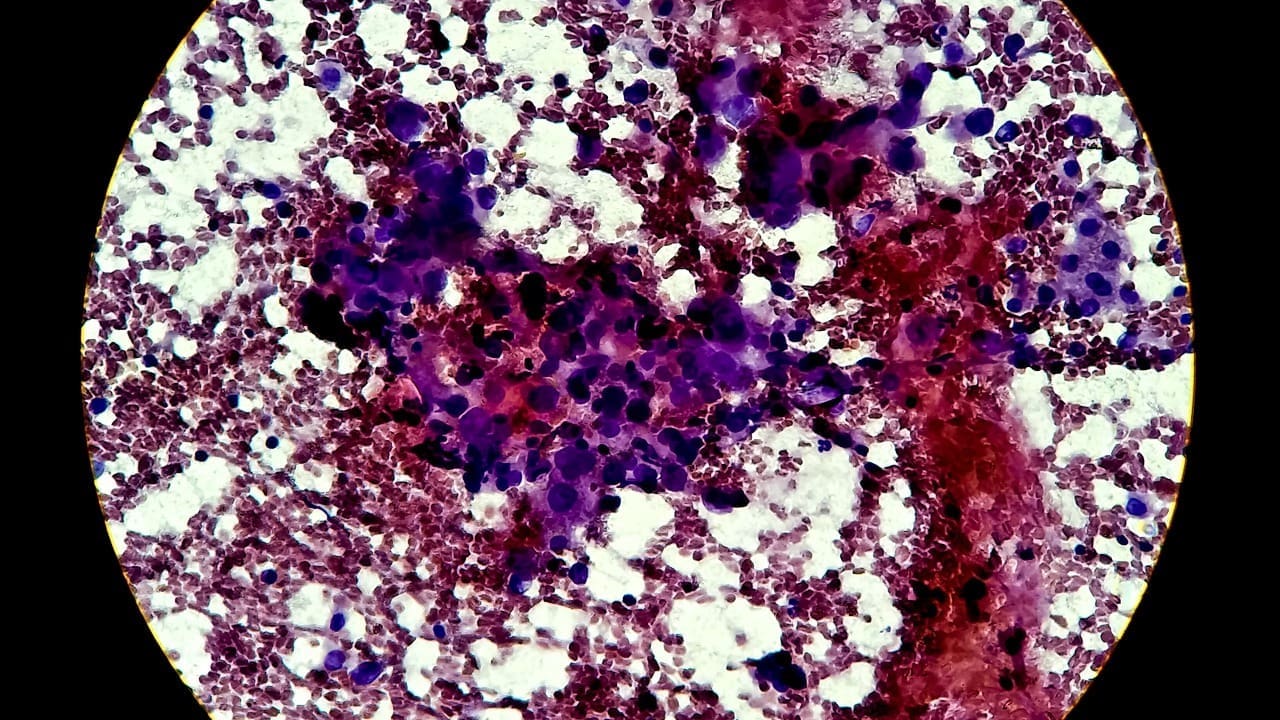Last Updated on November 26, 2025 by Bilal Hasdemir

Getting a diagnosis of Diffuse Large B-Cell Lymphoma can feel scary. DLBCL is the most common type of non-Hodgkin lymphoma, making up about one-third of NHL cases worldwide. It’s a fast-growing cancer, but thanks to new treatments, it can be cured.
At Liv Hospital, we’re all about top-notch healthcare for international patients. We focus on you, making sure you get the best care. DLBCL needs quick and strong treatment, and we’re here to guide you through it.
Key Takeaways
- DLBCL is the most common type of non-Hodgkin lymphoma.
- It is an aggressive cancer that requires prompt treatment.
- Modern treatments offer a possible cure for DLBCL.
- Liv Hospital provides patient-centered care for international patients.
- Our approach ensures clarity and confidence in your treatment journey.
Understanding Diffuse Large B-Cell Lymphoma (DLBCL)
To tackle DLBCL, it’s key to understand its basics. This includes its definition, medical terms, and what makes it unique. We’ll explore DLBCL in detail, aiming to give you a solid grasp of this complex disease.
Definition and Medical Terminology
Diffuse Large B-Cell Lymphoma (DLBCL) is a fast-growing lymphoma type. It’s marked by large B cells. The term “diffuse” means the cancer cells spread out, not staying in one spot. Knowing the different types and subtypes of DLBCL is important for treatment planning.
Antibody drug conjugates (ADCs) are showing great promise in treating DLBCL. This is based on recent studies on the lymphoma treatment market.
DLBCL Meaning and Abbreviations
DLBCL has its own set of abbreviations. Knowing these is key for clear communication among doctors and patients. Terms like BLBCL and DCBCL are used, but DLBCL is the most common. Clearing up these terms helps avoid confusion.
Characteristics of B Cell Diffuse Lymphoma
B Cell Diffuse Lymphoma is aggressive and fast-growing. It often affects the lymph nodes, spleen, or other lymphoid areas. Symptoms can include fever, night sweats, and weight loss. Knowing these signs is key for diagnosing and treating DLBCL.
| Characteristics | Description |
|---|---|
| Aggressive Nature | DLBCL is known for its rapid progression and aggressive behavior. |
| Lymphoid Tissue Involvement | The disease often involves the lymph nodes, spleen, and other lymphoid tissues. |
| Symptoms | Common symptoms include fever, night sweats, weight loss, and fatigue. |
Large B Cell NHL: The Most Common Form of Non-Hodgkin’s Lymphoma
Diffuse Large B-Cell Lymphoma (DLBCL) is the most common type of Non-Hodgkin Lymphoma. It grows quickly but can be cured with the right treatment. We’ll look at how common DLBCL is, what makes it different, and why it’s so aggressive.
Prevalence and Epidemiology
DLBCL makes up about 30% of all Non-Hodgkin Lymphoma cases globally. It’s more common in Western countries. In the U.S., about 7-8 people out of 100,000 get DLBCL each year.
| Region | Annual Incidence Rate (per 100,000) |
|---|---|
| North America | 7-8 |
| Europe | 6-7 |
| Asia | 3-5 |
Distinguishing DLBCL from Other Lymphomas
DLBCL is different from other lymphomas because of its unique features. It has large B cells that spread through lymphoid tissues. Doctors diagnose DLBCL by looking at its appearance, markers, and genes.
Key diagnostic features include:
- Diffuse growth pattern
- Large B cells with prominent nucleoli
- Expression of B cell markers (e.g., CD20, CD79a)
- Genetic abnormalities (e.g., MYC, BCL2 rearrangements)
The Aggressive Nature of Non-Hodgkin’s Lymphoma DLBCL
DLBCL grows fast and can spread outside the lymph nodes. But, with the right treatment, many people can be cured.
The aggressive nature of DLBCL means it needs quick diagnosis and treatment. Knowing how DLBCL works helps doctors find better ways to treat it and improve patient outcomes.
Causes and Risk Factors for DLBCL
The exact causes of Diffuse Large B-Cell Lymphoma are not fully understood. But, several risk factors have been identified. Knowing these can help us understand who might be at risk and how to prevent it.
Genetic Predispositions
Genetics play a big role in DLBCL. Some genetic mutations can make people more likely to get this lymphoma. For example, changes in genes that control cell growth can lead to cancer in B cells.
Research into lymphoma biology is helping us learn more about these genetic factors. This knowledge can lead to better treatments.
Environmental and Lifestyle Influences
Environmental and lifestyle factors also affect DLBCL risk. Exposure to chemicals like pesticides and solvents can increase the risk. Viruses, like Epstein-Barr Virus (EBV), can also raise the risk.
Lifestyle choices, like diet and exercise, might also play a role. But, we need more research to understand these connections fully.
Immune System Dysfunction and Prior Conditions
Immune system problems are key in DLBCL development. People with weakened immune systems, like those with HIV/AIDS, are at higher risk. So are those taking immunosuppressive drugs after organ transplants.
Certain medical conditions, like autoimmune diseases, can also raise the risk. Knowing these risks helps us watch and possibly prevent DLBCL in high-risk individuals.
Signs and Symptoms of D Cell Lymphoma Cancer
It’s important to know the signs and symptoms of Diffuse Large B-Cell Lymphoma. This cancer often shows up as swollen lymph nodes that don’t hurt. These swellings can grow fast and are a key sign of the disease.
Common Presenting Symptoms
The most common symptom is swollen lymph nodes. These can be in the neck, armpits, or groin. The swelling is usually painless and grows quickly. Other symptoms include:
- Painless lymphadenopathy: Enlargement of lymph nodes without pain.
- Systemic symptoms: Such as fever, night sweats, and weight loss, collectively known as B symptoms.
- Fatigue: Persistent tiredness that doesn’t improve with rest.
B Symptoms in Lymphoma
B symptoms are signs that can happen in lymphoma patients. They include:
- Fever: Elevated body temperature, often above 38°C.
- Night sweats: Recurring episodes of severe sweating at night.
- Weight loss: Unintentional loss of more than 10% of body weight over six months.
Having B symptoms means the disease might be more aggressive. It can also change how treatment is planned.
Extranodal Manifestations of DLBC Cancer
DLBCL can also affect organs and tissues outside the lymph nodes. Common places include:
- Gastrointestinal tract: Symptoms may include abdominal pain, bleeding, or obstruction.
- Bone marrow: Involvement can lead to anemia, infection, or bleeding disorders.
- Central nervous system: Rarely, DLBCL can present with neurological symptoms such as headaches, confusion, or seizures.
It’s vital to recognize these signs and symptoms early. This helps in diagnosing and managing DLBCL effectively. If you or someone you know has these symptoms, getting medical help quickly is important.
Diagnosis of Non-Hodgkin DLBCL
To diagnose DLBCL, we use a detailed process. This includes a biopsy, imaging, and lab tests. These tools help us spot Non-Hodgkin DLBCL and tell it apart from other lymphomas.
Biopsy and Pathological Examination
A biopsy is key in diagnosing DLBCL. We take tissue samples from the affected area. Then, we look at these samples under a microscope for signs of DLBCL, like large B cells.
This examination confirms the diagnosis and rules out other conditions.
Imaging Studies for Large B Cell Non-Hodgkin Lymphoma
Imaging is vital for diagnosing and understanding Large B Cell NHL. We use CT scans, PET scans, and MRI to see how far the disease has spread. These scans help us figure out the disease’s stage and plan treatment.
Laboratory and Molecular Testing
Laboratory tests are key in diagnosing DLBCL. We do blood tests to check overall health and look for signs of lymphoma. Molecular tests, like immunohistochemistry and genetic analysis, help us find specific markers of DLBCL.
This info is vital for creating a treatment plan that fits the patient’s needs.
In summary, diagnosing lymphoma diffuse large B-cell type involves a biopsy, imaging, and lab tests. These steps help us accurately diagnose DLBCL and plan the best treatment.
Classification and Staging of Large B Cell Lymphoma Non-Hodgkins
Knowing how to classify and stage DLBCL is key. It helps figure out the best treatment and what to expect. We’ll look at the ways to classify and stage this complex cancer.
Molecular Subtypes of DLBCL
DLBCL is made up of different molecular subtypes. These are based on genetic and expression profiles. The main types are germinal center B-cell-like (GCB) and activated B-cell-like (ABC) DLBCL.
Ann Arbor Staging System
The Ann Arbor Staging System is used to stage DLBCL. It divides the disease into four stages. These stages depend on how many lymph nodes are affected and if the disease has spread.
Stage I means the disease is in one lymph node group. Stage IV means it’s spread a lot.
International Prognostic Index (IPI)
The International Prognostic Index (IPI) predicts how well a patient will do. It looks at age, how well the patient can function, stage, and more. It helps doctors decide on treatment based on risk.
Double-Hit and Triple-Hit Lymphomas
Double-hit and triple-hit lymphomas are special types of DLBCL. They have a worse outlook than other DLBCLs. These types are found through genetic tests.
Knowing about these types helps doctors plan more aggressive treatments.
Understanding DLBCL’s classification and staging is vital. It lets doctors tailor treatments for better results. Using molecular info, staging systems, and prognostic tools makes treatment more personal.
Treatment Approaches for Large B Cell Non-Hodgkin Lymphoma
We will look at the current treatments for large B cell non-Hodgkin lymphoma. We will focus on first-line treatments and options for when the disease comes back or doesn’t respond. The treatment for DLBCL has changed a lot, thanks to new therapies. This has made things better for patients.
First-Line Therapies
First-line treatment for DLBCL usually combines chemotherapy and immunotherapy. The most common treatment is R-CHOP. It includes rituximab, cyclophosphamide, doxorubicin, vincristine, and prednisone. This mix has greatly improved survival rates for DLBCL patients.
Key Components of R-CHOP Therapy:
- Rituximab: A monoclonal antibody targeting CD20 on B cells
- Cyclophosphamide: A chemotherapy drug that interferes with DNA replication
- Doxorubicin: A chemotherapy drug that intercalates DNA strands
- Vincristine: A chemotherapy drug that disrupts microtubule formation
- Prednisone: A corticosteroid that has anti-inflammatory and immunosuppressive effects
| Treatment Regimen | Key Components | Efficacy |
|---|---|---|
| R-CHOP | Rituximab, Cyclophosphamide, Doxorubicin, Vincristine, Prednisone | Significantly improves overall survival in DLBCL patients |
| DA-EPOCH-R | Dose-adjusted Etoposide, Prednisone, Vincristine, Cyclophosphamide, Doxorubicin, Rituximab | Effective in treating DLBCL, even in high-risk patients |
Treatment for Relapsed or Refractory Disease
For patients with DLBCL that comes back or doesn’t respond, new treatments are available. These include antibody drug conjugates (ADCs) like Zynlonta and Polivy. They have shown promise in clinical trials.
Antibody Drug Conjugates (ADCs):
- Zynlonta (loncastuximab tesirine): Targets CD19 on B cells
- Polivy (polatuzumab vedotin): Targets CD79b on B cells
These new therapies offer hope for patients with relapsed or refractory DLBCL. They provide options when traditional treatments don’t work.
Living with Diffuse Large B-Cell Lymphoma
Managing DLBCL is more than just treating the cancer. It’s about taking care of the patient’s overall well-being. Getting a diagnosis of DLBCL can feel overwhelming. But with the right support, patients can get through this tough time.
Managing Side Effects of Treatment
Treatment for DLBCL may include chemotherapy, radiation, and immunotherapy. Each treatment can have side effects. It’s important to manage these to keep the patient’s quality of life good.
- Chemotherapy Side Effects: Nausea, fatigue, hair loss, and a higher risk of infections.
- Radiation Therapy Side Effects: Fatigue, skin changes, and a chance of getting secondary cancers later.
- Immunotherapy Side Effects: Infusion reactions and immune-related side effects that can affect different organs.
We suggest talking to the healthcare team about possible side effects. This way, a plan can be made to manage them.
Follow-up Care and Monitoring
After treatment, follow-up care is key. It helps monitor the patient’s health and catch any signs of relapse early. This care includes regular check-ups, imaging tests, and blood work.
| Follow-up Component | Description | Frequency |
|---|---|---|
| Physical Examination | Checking for signs of relapse or treatment side effects | Every 3-6 months for the first 2 years |
| Imaging Tests | CT scans or PET scans to monitor disease status | As recommended by the healthcare team, typically every 6-12 months |
| Blood Work | Monitoring blood counts and other markers | Regularly, as advised by the healthcare provider |
Support Resources and Coping Strategies
Living with DLBCL is tough, both physically and emotionally. It’s important to find support and coping strategies.
“The emotional support I received from my healthcare team and support groups made a significant difference in my ability to cope with DLBCL.” – Patient Testimonial
There are many support resources available. These include counseling, support groups, and educational materials. We encourage patients to explore these to find what works best for them.
Clinical Trials and Emerging Therapies
Some patients might want to join clinical trials. These trials offer new therapies not yet widely available. Treatments like bispecific ADCs are promising for DLBCL.
We suggest talking to a healthcare provider about the benefits and risks of joining a clinical trial.
Conclusion
We’ve looked into Diffuse Large B-Cell Lymphoma (DLBCL), a common non-Hodgkin lymphoma. It’s aggressive and has many symptoms. DLBCL needs quick diagnosis and treatment.
New treatments like antibody drug conjugates have helped patients with DLBCL. These treatments offer hope for those with this disease.
Knowing the causes, symptoms, and how to diagnose d cell lymphoma cancer is key. The type and stage of large B cell lymphoma help doctors plan treatment.
As we keep learning about DLBCL, finding new treatments is vital. This helps improve care for those with the disease.
FAQ
What is Diffuse Large B-Cell Lymphoma (DLBCL)?
DLBCL is a fast-growing type of non-Hodgkin lymphoma. It’s the most common non-Hodgkin lymphoma worldwide.
What does DLBCL stand for in medical terms?
DLBCL stands for Diffuse Large B-Cell Lymphoma. It’s also known as DLBCL, DCBCL, or BLBCL. But DLBCL is the most accepted term.
How common is DLBCL among non-Hodgkin lymphomas?
DLBCL is the most common type of non-Hodgkin lymphoma. It makes up about 30-40% of all cases.
What are the risk factors for developing DLBCL?
Risk factors include genetic predispositions and certain infections. Immune system issues and lifestyle factors also play a role.
What are the common symptoms of DLBCL?
Symptoms include swollen lymph nodes and fever. Night sweats, weight loss, and fatigue are also common. Extranodal symptoms depend on the disease site.
How is DLBCL diagnosed?
Diagnosis involves biopsy and pathological examination. Imaging studies like PET/CT scans are also used. Blood counts and molecular studies are part of the process.
What is the Ann Arbor Staging System used for in DLBCL?
The Ann Arbor Staging System stages DLBCL based on disease spread. It helps predict prognosis and guide treatment.
What treatment options are available for DLBCL?
Treatment often includes chemotherapy and rituximab, a monoclonal antibody. Radiation therapy, CAR-T cell therapy, and clinical trials are also options.
Can DLBCL be cured?
Yes, DLBCL can be cured with modern treatments. Cure chances depend on diagnosis stage, health, and treatment response.
What are the side effects of DLBCL treatment, and how are they managed?
Side effects include nausea, fatigue, hair loss, and infection risk. Management involves supportive care, lifestyle changes, and follow-up care.
Are there any new or emerging therapies for DLBCL?
Yes, new therapies like antibody-drug conjugates and bispecific antibodies are being researched. They offer new treatment options for patients.








